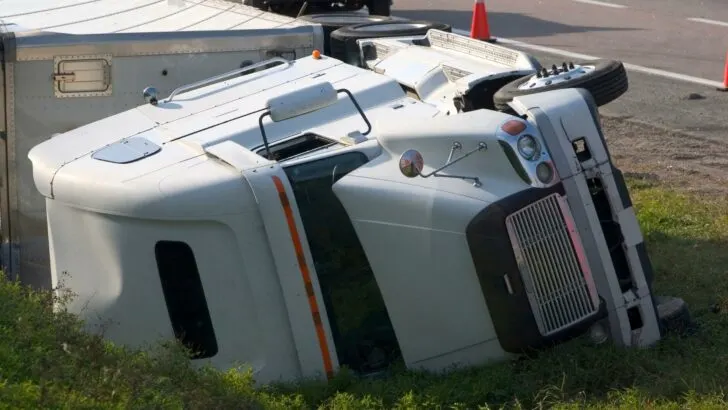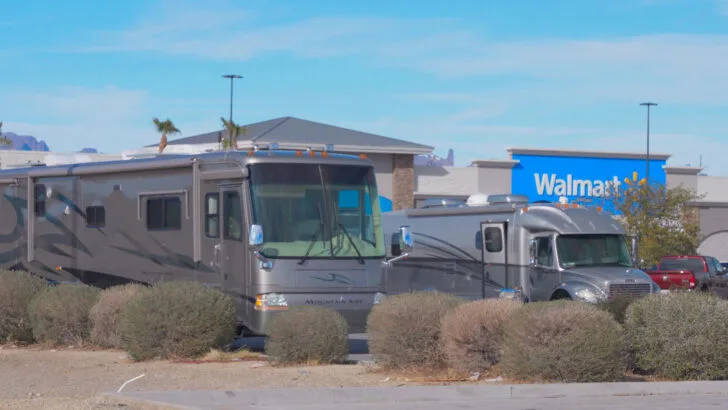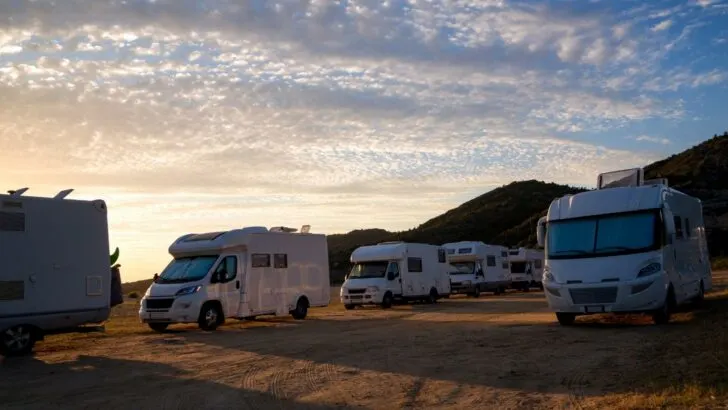Almost anyone who has ever had the displeasure of driving an RV in high winds will tell you that it can be a very stressful white-knuckle experience.
No one likes driving an RV in high winds, but the situation is likely to present itself sooner or later. For this reason, we’re here to share some suggestions that we hope will be helpful in keeping you safe on the road in windy conditions.
- 1) Are RVs Vulnerable to Heavy Winds?
- 2) When Is it To Windy to Drive an RV?
- 3) Factors to Consider When Driving Your RV in Windy Conditions
- 4) Can Wind Actually Tip an RV Over While Driving?
- 5) How Much Wind Can a Parked RV Withstand?
- 6) What is a Safe Driving Speed in Windy Conditions?
- 7) What Are Wind Restrictions?
- 8) Driving Tips for Windy Conditions
- 9) Other Important Information to Know When Driving an RV in Windy Conditions
- 10) Have You Experienced Driving an RV in Windy Conditions?
Are RVs Vulnerable to Heavy Winds?
RVs are especially vulnerable to heavy winds because of the large surface area of the RV, which leaves no place for the wind to pass through to relieve the pressure. The wind simply pushes against the sides/front/rear of the RV and can literally move the rig, no matter how heavy it is.
Travel trailers are highly susceptible to trailer sway in heavy winds. This can lead to driver over-correction, resulting in a back-and-forth rocking that can send the trailer out of control.
It’s can be tiring to drive or tow an RV in high winds, and sometimes it can be downright dangerous. It’s at these times when you may have no choice but to find a safe area to pull over and stop driving until conditions improve.
When Is it To Windy to Drive an RV?
High winds are capable of overturning an RV. The longer and taller an RV is, the more surface area the wind has to push against. But this can happen with any RV. Even smaller RVs are taller than a typical vehicle, so we’ve all got more surface area.
There are many factors involved that may mean it’s “too windy” to stay on the road, so there’s no specific wind speed to watch out for. But we’ll cover some of the ways you can determine what’s safe, what’s not, and when it’s time to get off the road. Bottom line… we don’t think taking chances driving an RV in dangerously high winds is ever wise.

There are several factors to consider when determining if it’s too windy to drive your RV.
Factors to Consider When Driving Your RV in Windy Conditions
There are four primary factors to consider when driving your RV in windy conditions:
- Wind speed
- Wind direction
- Driving speed
- How heavily the RV is loaded in relation to its GVWR (gross vehicle weight rating)
All of the factors noted above combine to create greater potential for problems. The higher the wind, the faster you drive, the closer your vehicle is to its maximum allowable weight, and the more direct the wind is to a 90° crosswind, the more dangerous it is to drive in windy conditions.
Higher wind speed, directly on the side of a heavily loaded RV = SLOW DOWN! If it’s still not a stable drive, find a safe place to stop and take a break!
If the wind is causing you to leave your lane while you’re driving, it’s time to stop. None of us wants to tip over, but swerving in your lane can be very dangerous as well – to you and to others on the road.
You’ll notice that of the four factors listed above, only one of them is under your direct control as you’re rolling down the road and feeling “pushed around” — Driving speed. We’ll get to more on that below.
Can Wind Actually Tip an RV Over While Driving?
Again, YES – the wind can tip an RV over, especially while you’re driving it. (There’s far less chance of the wind toppling an RV that’s parked.) The force of the wind combined with the force of wind being generated by your rig can combine to tip your RV over completely. This is why it’s important to always be aware of how your rig is behaving on the road, and respond accordingly based on conditions.

If high winds can overturn a much heavier vehicle like a tractor trailer, your RV could suffer the same fate.
How Much Wind Can a Parked RV Withstand?
A parked RV can withstand far more wind than a moving RV. The likelihood of wind tipping over a parked RV is low, but you may feel the rig rocking uncomfortably, especially if you don’t have leveling jacks.
Leveling jacks can help to stabilize your RV in heavy winds. If possible, you may also want to park your RV so that the front or rear of the rig is facing into the wind. This way, the full strength of the wind isn’t hitting the largest side of the RV.
What is a Safe Driving Speed in Windy Conditions?
RVs vary so much in size, shape, and weight that there’s no way to suggest a single driving speed that’s safe for every RV in every wind condition. The important thing to remember is that the more vulnerable your rig is to the wind (see the four conditions above), the slower you need to drive (again, the primary factor that you’re in control of while rolling down the road).
While longer, taller RVs can act like a sail and catch a lot of wind, all RVs are susceptible to being affected by very high winds. So all RVers should take safety precautions.
One factor that each of us has a considerable degree of control over is weight. Making sure to avoid overloading your rig is key for many reasons, including stability on the road.
How Much Wind is Too Much?
Again, there’s no one set wind speed that triggers a “get off the road” response from every RVer. There are simply too many factors at play. But there is a way to know when you should slow down, or get off the road altogether.
Keeping in mind what we mentioned earlier – that driving speed is the variable that you have the most control of while underway – we recommend using that as your primary control factor.
We suggest using a “bottom-up” approach to anything related to driving speed. By that, we mean that you should start slowly, and work your way up as conditions allow. It’s far easier to increase your speed if you’re driving a little slower than needed than it is to be forced to slow down (possibly suddenly!) because things are getting hairy.
If the wind (regardless of its speed) is pushing your rig around, causing you to sway in (or out of) your lane, or causing you to feel uncomfortable, that’s your sign to slow down. And if necessary, find a place to stop and wait for better conditions.
Any time we’re not in complete control of our RV, we shouldn’t be driving.
If you need to pull over for the rest of the day, check out our post on free overnight RV parking and you might find the perfect spot. And if you’re wondering if you can camp in a Walmart parking lot, no – you can’t camp there. But many Walmarts, and other locations, offer a safe, comfortable place to wait out a storm and/or even stay overnight.

There are times when the safest thing to do is to pull over and spend the night in a Walmart parking lot to wait out the wind.
What Are Wind Restrictions?
You may sometimes see overhead signs warning of high winds. Some areas may even implement restrictions to limit high-profile traffic during extremely windy conditions. Typically, the vehicles that are restricted in those zones are large trucks and RVs, so always check the area you’ll be traveling in for potential wind restrictions. These are put in place for your safety and for the safety of others using the roads in that area.
There may also be wind restrictions placed on bridges that span across the water, due to the wind gusts that often occur in these open areas. Doing a little research prior to hitting the road and staying alert for changing conditions can save you a lot of stress and keep you safe.
Driving Tips for Windy Conditions
Following are some tips for driving an RV in high winds. All of them will help to keep you safer on the road in windy conditions.
Slow Down
When in heavy winds in an RV, adjust your driving speed. In two words, this simply means SLOW DOWN. If you feel your rig being pushed around, your first reaction should be to slow down. If it’s still not feeling stable, slow down more. Or get off the road in the earliest safe spot.
Check the Weather Forecast and Wait If Necessary
Check the weather forecast and give yourself the benefit of a plan B that allows you to wait out the wind. The winds won’t blow forever, and you just might enjoy an unexpected day of relaxation while you wait.
Drive With Both Hands on the Wheel

It’s a good policy to drive with both hands on the wheel to remain prepared for powerful gusts of wind when driving an RV in windy conditions.
Since you should always keep both hands on the wheel anyway, this should probably go without saying. But we’ll say it anyway: when you’re driving in windy conditions, keeping both hands on the wheel is more important than ever. You just don’t know when a gust of wind is going to hit your rig in just the wrong way and you’re going to need to have full control.
Having both hands on the wheel keeps you prepared for the unexpected (at all times), and is the habit of every good defensive driver.
Be Careful While Driving on Bridges and Overpasses
Bridges and overpasses are common places for gusty side winds, so be alert. Also, large trucks passing your rig may create the same sort of wind disturbance, so be prepared when being passed.
But be sure to avoid overcorrecting as those gusts come and go. As with so many situations involving driving safety, reducing your speed should be a natural first response.
Take Breaks Often
When you’re driving in winds that aren’t excessive enough to pose a danger, you may be able to continue driving comfortably, at appropriate speeds. Even so, taking routine breaks is important. Operating an RV in windy conditions is more tiring and stressful, and taking breaks keeps you in better condition to drive safely.

There are times when the winds are so high that you may see a large number of RVs that have pulled off the road to wait out the windy conditions.
Other Important Information to Know When Driving an RV in Windy Conditions
We have several posts that we think you’ll find helpful in preparation for driving in high winds. First, our post on the most common RV accidents has lots of information to be aware of anytime you drive an RV.
Knowing how to adjust RV mirrors is essential to safe RV driving, as is having a clear understanding of trailer sway control if you’re towing a travel trailer.
We also suggest catching up on our RVgeeks Driving School, including our post on how to drive an RV – off tracking and rear overhang.
In fact, we’ll leave our entire RVgeeks Driving School in video format right here for you. We want you to be as safe on the road as possible!
Have You Experienced Driving an RV in Windy Conditions?
So tell us – have you experienced driving an RV in windy conditions? What did you do to remain safe on the road? Do you have personal policies that you adhere to when driving your rig in windy conditions? Please leave us a comment to let us know!
Geek Out with Us Every Week
Join our newsletter to learn about all things RV-related. Every week we offer free tips, tricks, product reviews, and more to our online community of RVers. So, whether this is your first time on the road or you’re a seasoned expert, we’d love for you to geek out with us!


Tom Portwood
Sunday 2nd of July 2023
I forgot to mention a very useful travel app. It is Drive Weather, you put in your current location and your destination and it will show weather along your route at the time you will get to that part of the route, it can show temperature, rain, and wind.
Tom Portwood
Sunday 2nd of July 2023
I have also added a steering stabilizer to our 32’ Fleetwood Class A gas coach, it does help with wind and definitely helped me maintain control after a steer tire blowout last year,
Came across this several years ago, but I think it is for stationary vehicles and I can’t vouch for its accuracy. The wind force on your RV is: wind force = Lenght x Height x F where F is: 20 at 90 mph 29.8 at 110 mph 41.8 at 130 mph For example, a 30 ft RV 8 ft high (the sheeting only) will have a 7154 lb force pushing on it in a 110 mph wind (gust, not average). If this is more than the weight of the RV it will likely flip over. You should have, at least, a 50% safety factor, so the RV should weigh at least 10731 lb to be safe. These forces go up as the square of wind speed, so a 130 mph wind will produce a 10000 lb force. This is the worst case scenario with the wind hitting the RV square on; if the wind is at a 45 degree angle reduce the force by 30% (cosine of the angle).
Marc Goldstone
Sunday 2nd of July 2023
If you must drive your RV in windy conditions having a lower center of gravity is beneficial to reduce the chances of rollover. Driving with a full fresh water tank could help if the water tank is near the bottom of your rig. Be sure not to exceed the maximum allowable vehicle weight as water weighs 8 pounds per gallon.
I highly recomend a free APP called WINDY which clearly displays the predicted wind speed and direction along your route for up to 10 days. The APP can also display Wind Gusts which I find most helpful. I check this APP several days before departure to chose the best and safest travel days.
Neal Davis
Sunday 10th of July 2022
We were driving our 43' DP through Texas in February a few years ago and the wind was strong enough to disturb the slide in the main salon. We pulled over at the first opportunity, seconds later, and called our manufacturer, American Coach. They told me that the slide was shifting but would not fall out. Nonetheless I drove much slower, probably below the posted speed, until the wind subsided. I did find the comment about weight odd. I always slow in high winds with the idea that it effectively makes my vehicle heavier and less susceptible to the wind. Thank you for the article; great information and even moreso a reminder of the dangers of high winds.
TheRVgeeks
Sunday 10th of July 2022
Wow, Neal... must've been some wind!
Pat Parker
Sunday 3rd of July 2022
Great article thanks for sharing